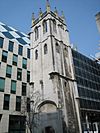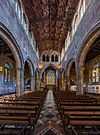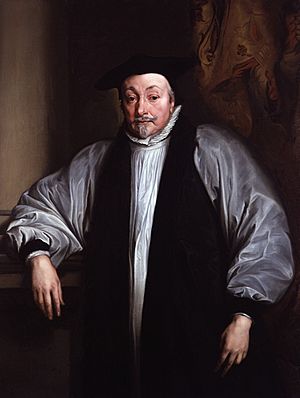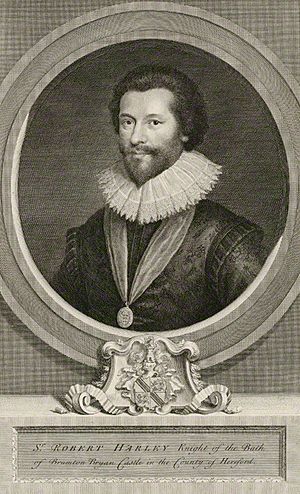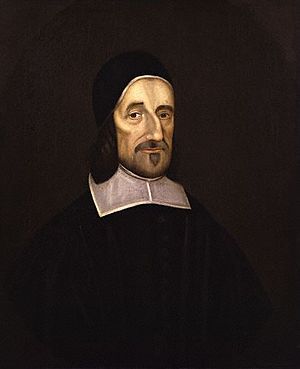Samuel Fisher (died 1681) facts for kids
Quick facts for kids Samuel Fisher |
|
| Born | 1605/6 in Northampton |
|---|---|
| Died | 1681 in Birmingham |
| Nationality | English |
| Church | Church of England, later Nonconformist. |
| Education | University of Oxford |
| Ordained | 18 December 1630 |
| Writings | An Antidote against the Fear of Death A Love Token for Mourners A Fast Sermon. |
| Offices held | Rector of Upton Magna Preacher at St Alban, Wood Street Vicar of Mary's, Shrewsbury Minister of Bride's, London Rector of Mary's, Thornton-le-Moors Licensed Presbyterian preacher in Birmingham. |
| Spouse | Unknown |
| Children | Samuel, Hannah, Charles. |
Samuel Fisher (born around 1605 – died 1681) was an English Puritan clergyman and writer. He strongly believed in the Presbyterian polity, a way of organizing the church where local churches are governed by elected elders. He started his career as a rector (a type of church leader) in Shropshire during the time of King Charles I. This was a period when the king tried to rule without Parliament, known as an absolute monarchy.
Later, Samuel Fisher worked in London and Shrewsbury during the English Civil War and the Commonwealth (when England was a republic). He then moved to Cheshire during the Protectorate (when Oliver Cromwell ruled). After the Great Ejection of 1662, when many non-Anglican ministers were forced out of their churches, he settled in Birmingham. There, he became a nonconformist preacher, meaning he didn't follow the rules of the official Church of England.
Contents
Early Life and Education
Samuel Fisher was born in Northampton in late 1605 or early 1606. He was the son of John Fisher. In 1623, when he was about 18, he started studying at Trinity College, Oxford, which is part of the University of Oxford.
He earned his first degree (B.A.) from Trinity College in 1627. Then, in 1630, he got his master's degree (M.A.) from New Inn Hall. This college was known for its Puritan beliefs at the time.
Samuel Fisher's Career Journey
| Location | Dates | Job Title | Illustration | Caption | Coordinates |
|---|---|---|---|---|---|
| Upton Magna | 1635–42 | Rector (church leader) supported by the Barker family. | St Lucia's church, Upton Magna, an old church with parts from the Norman period. | 52°42′29″N 2°39′45″W / 52.708070°N 2.662441°W | |
| Withington | 1635–42 | A smaller church linked to Upton Magna. | St John the Baptist, Withington: a church rebuilt in the Victorian era. | 52°42′46″N 2°37′40″W / 52.712803°N 2.627755°W | |
| St Alban, Wood Street | 1643–6 | A London church whose income was taken over by Parliament. | The tower is all that remains of St Alban's. The church was destroyed in World War II. | 51°31′00″N 0°05′39″W / 51.516585°N 0.094087°W | |
| Mary's, Shrewsbury | 1646–50 | A church in Shrewsbury, where Fisher was a vicar and a teaching elder in the local Presbyterian group. | The inside (nave) of St Mary's, Shrewsbury, mostly from the Middle Ages. | 52°42′31″N 2°45′05″W / 52.708733°N 2.751399°W | |
| Bride's, London | 1651, 1652–4 | A church in London, where the local church committee took control. | St Bride's church as it looked in the mid-1500s. | 51°30′50″N 0°06′20″W / 51.513767°N 0.105518°W | |
| Mary's, Thornton | 1654–62 | Rector, supported by Sir George Booth. | St. Mary's, Thornton-le-Moors, seen from the churchyard. | 51°30′50″N 0°06′20″W / 51.513767°N 0.105518°W | |
| Birmingham | 1662–81(?) | Nonconformist preacher, allowed to preach as a Presbyterian teacher in 1672. | 52°28′37″N 1°53′36″W / 52.476958°N 1.893243°W |
Early Career and Challenges
Samuel Fisher was ordained as a priest on December 18, 1630, by Bishop Thomas Morton in Eccleshall. The years between 1630 and 1635, before he became rector at Upton Magna, are not fully known.
In 1633, Fisher gave an important sermon in Shrewsbury. This was after Bishop Robert Wright had visited the area, promoting strict High Church ideas. These ideas were part of the "Laudian" movement, led by William Laud, the Archbishop of Canterbury. Fisher's sermon was a strong protest against these changes, which he felt threatened the "free passage of out blessed Gospel" and could lead to a return to popery (Catholicism). He likely preached at St Mary's Church, Shrewsbury, which was controlled by the town and allowed guest preachers.
Serving at Upton Magna
Samuel Fisher became the Rector of Upton Magna on July 21, 1635. This church was supported by the Barker family, who were Parliamentarians. Fisher worked across the whole parish, including Withington, which was a smaller church linked to Upton Magna.
Fisher was a Puritan, like his patron Walter Barker. He often spoke out against ideas he disagreed with. For example, he criticized Peter Studley, a local clergyman, who wrote a book blaming Puritan beliefs for a murder. Fisher also reported a "seminary priest" (a Catholic priest trained abroad) named Francis Rowley for speaking badly about Puritan leaders.
As the English Civil War approached in 1642, Fisher and Barker tried to gather support for Parliament. However, local Royalists (supporters of the King) took control of Shrewsbury. Fisher had to leave Upton Magna, possibly going to London.
Working in London
On January 23, 1643, the House of Commons decided that the income from the church of St Alban, Wood Street in London should be taken over by Parliament. They appointed "Mr. Fisher, an orthodox Divine," to preach there. The previous church leader had joined the Royalists. This was likely the same Samuel Fisher who had left Shropshire. He stayed at St Alban's until 1646, which fits with his return to Shropshire later that year.
Time in Shrewsbury
New Role in Shrewsbury
Fisher was appointed to St Mary's in Shrewsbury by the town council around August 21, 1646. He was known as a "curate" there, which meant he was the main church leader, not an assistant. He replaced James Betton, who had moved away. Fisher received a good salary for his work. Another important church leader in Shrewsbury was Thomas Paget, who was a strong supporter of the Presbyterian way of organizing the church.
The Presbyterian Plan
After the Civil War, Parliament wanted to reorganize the English Church to be more Presbyterian, as they had promised their Scottish allies. Shropshire was one of the few counties that tried to make this happen. A plan from April 1647 divided Shropshire into six areas, each with a "classis" or "classical presbytery." This was a group of ministers and lay elders (church members who were not ministers) who would govern the churches in their area.
Shrewsbury was the center of the First Classis. Fisher was listed as one of the key clergy members for this group. The lay elders included important town leaders like the mayor, merchants, and local gentry, such as Fisher's old friend Robert Charlton. The most powerful person in the classis and the town was Humphrey Mackworth, who was the military governor.
Back in London
Fisher preached at Bride's in London for two short periods between leaving Shrewsbury and moving to Thornton. The church's local committee, which supported Parliament, had taken control of the church.
Fisher became a "lecturer" at Bride's on April 28, 1651. He then became an "entertained minister" from June 30, 1652, earning a good salary. While at Bride's, he gave funeral speeches for two women and later published them in a book called A Love-Token for Mourners. This book also included An antidote against the fear of death, which he wrote in 1650 during a time of plague in Shrewsbury. He and Thomas Blake had stayed in Shrewsbury to care for their people during this difficult time.
Serving in Thornton
On May 25, 1654, Fisher became the rector of Thornton-le-Moors in Cheshire. This position was supported by Sir George Booth, a powerful landowner and a leader of the Presbyterian cause in Cheshire.
Cheshire did not have a formal Presbyterian system like Shropshire. Instead, ministers formed a voluntary group to help with ordaining new ministers and other church duties. Fisher was highly respected by the leaders of this group. For example, in 1656, when a minister named Henry Newcome was thinking about moving to Shrewsbury, Richard Baxter (a very influential Puritan writer) wrote to him, saying that Fisher's opinion was important because he knew both places well.
Fisher's patron, Sir George Booth, played a role in the events that led to the Restoration of the monarchy in 1660. Despite hopes for a Presbyterian church system, Fisher and his assistant, Samuel Edgley, were forced out of Thornton in the Great Ejection of 1662. This happened because they refused to follow the new rules of the Act of Uniformity 1662, which required all ministers to conform to the Church of England.
Life in Birmingham
After 1662, Fisher spent the rest of his life in Birmingham. He became a key figure among the nonconformists there. These were Protestants who did not belong to the Church of England. They tried to gain legal recognition for their meetings under the Royal Declaration of Indulgence issued by King Charles II in 1672.
In April 1672, Birmingham Presbyterians sent a petition to the King. They asked for permission for "Mr Samuel Fisher Master in Arts of the Presbiterian perswasiõ to excercise his Ministeriall functiõ amongst us." They also asked that Fisher's house and the Town-Hall in Birmingham be allowed as places for their meetings.
Fisher's eldest son, Samuel Fisher junior, helped coordinate these requests in the West Midlands. On May 1, 1672, the government officially granted licenses for Samuel Fisher's house to be a Presbyterian meeting place and for him to preach there.
Last Years and Family
Samuel Fisher lived in Birmingham until he died. He wrote his will on November 8, 1677. He was buried on September 5, 1681, at St Martin's Church in Birmingham.
Fisher was married, but his wife's name is not known. They had at least three children who lived to be adults: Samuel junior, Hannah, and Charles. By the time Fisher wrote his will in 1677, both his wife and his son Charles had passed away. His daughter Hannah was his main beneficiary, as she had cared for her parents in their old age.
Images for kids
See also
- Calvinism
- Savoy Conference
- Westminster Assembly




